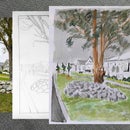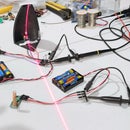Introduction: Photo Editing
This Instructable describes a simple method of enhancing photos using "color separation". All that is required is a photo editor that supports "layers" such as "Adobe Photoshop Elements ® ".
The technique involves separating the the color and luminosity information, optimizing each, then recombining the two lots of information.
The "opening" photo shows each of the four stages. Counter-clockwise from the lower left we have:
- the original photo
- the luminosity information
- the color information
- the final optimized image
Compared to RGB [1] editing "color separation" offers the following advantages:
- adjusting the color does not alter the luminosity
- adjusting the luminosity does not affect the color
- color artifacts are not introduced when the image is sharpened
Before and after images follow.
[1] Red, Green, Blue
Step 1: Some Theory
[ Feel free to skip this step ]
There are many methods of describing color. A simplified explanation follows:
The color wheel
The color wheel above is for light. It shows the three primary colors (R)ed, (G)reen, (B)lue, and their opposite (complimentary) colors (C)yan, (M)agenta, and (Yellow).
When projected, equal amounts of RGB produce the color "white". This process is referred to as "additive" mixing.
When mixed, equal amounts of CMY inks will produce the color "black". Actually it's a dark muddy brown so printer manufacturers add a "black" cartridge to make a true "black"... hence the term CMYK where (K) stands for blac(K).
The reason the inks produce "black" is that each color "absorbs" light. For instance yellow reflects yellow and absorbs all other colors ... hence the term "subtractive" mixing.
The color wheel above is a 2-dimensional method of visualizing color. In practice color is best understood by looking at a 3-dimensional model.
Color space
The second image depicts a "color space". Images similar to this often appear in photo magazines. So what are they. Basically they depict all possible colors that can be produced by, say, a printer, projector, or your computer screen.
Let's simplify "color space" by looking at two different concepts.
RGB
[ Equal amounts of RGB color form a continuous grayscale. ]
The third image shows the RGB color space mapped to a cube. Each of the primary colors share a common vertex. A "grayscale" is produced by mixing equal amounts of (R)ed, (G)reen, and (B)lue light.
Important points to note:
- each RGB axis is numbered 0-255 where 0=no light and 255=maximum light.
- each of the RGB axes join at the corner of a cube.
- the RGB value at the corner where they join is 0 which means there is no light ... we see "black".
- if you look diagonally through this cube to the opposite vertex you see a "color wheel"
- the diagonal to the opposite vertex forms a continous "grayscale" that goes from "black" to "white".
Most photo editors use this RGB color model.
Unfortunately RGB is NOT ideal for photo editing ... if you want to increase the brightness then you need to add equal amounts of RGB. Vary one color more than the others and your image will not only change in brightness, it will also change color.
To get around this, all photo editors provide you with "tools", such as "brightness", "contrast", "hue", and "saturation" to simplify your task. Most of the time these tools meet our everyday needs but occasionally we want more.
For example ... assume that your red channel is at 255 (maximum) and that you want to give your image some "punch". Any attempt to, say, increase the brightness will cause a loss of white detail, color artifacts, and hue changes, because the red channel value can't be increased beyond 255.
The L.a.b. colour model let's us "boost" our image without the above side effects.
L.a.b color
The final image depicts the L.a.b color model which comprises (L)uminosity information, and "a"-axis and "b"-axis color information. The "a" axis contains "green-magenta" information ... the "b" axis contains "blue-yellow" information. These two axes are at right-angles to each other which allows us to produce any color by mixing the axes in various combinations.
A way to visualise L.a.b is to extract the "grayscale" from the RGB model and call it "L" with "black"=0 and "white"=100. Now stand this "grayscale" on its end and feed some CD's (compact disks) over the resulting column. Make the colors on each CD identical except that their brightness is proportional to the luminosity at each position along the "grayscale". Again, If you look down the column, you will see our 2-dimensional color wheel.
This model has several advantages:
- adjusting the luminosity doesn't affect the color
- adjusting the color doesn't affect the luminosity
- it is able to describe all possible colors (even imaginary ones)
Television channels are similar to L.a.b. as they comprise two transmitted signals ... a "Luminosity" signal (which contains much of the detail) ... and a "color" signal. The TV set combines these two signals into a color image.
My photo editing method uses a similar technique.
Step 2: Extracting the Color
[ All screen shots were taken using "Adobe Photoshop Elements 8 ® " ]
Step 1
- Open the photo in your editor (File|Open)
Step 2
- Add a layer above the the background layer (Layer|New)
Step 3
- Fill the layer with 50% gray (Edit|Fill Layer|50% Gray)
Step 4
- Change the "layer 1" blending mode to "Luminosity" [1] and the color information will appear. Note the lack of any significant color detail.
Step 5
- Press the following four keys at the same time: "ctrl", "shift", "alt", and the letter "e". Remember this key combination if you are using "Photoshop" ... it’s called "Stamp Visible". Basically it gathers all of the information in the visible layers into a single layer.
- Rename this layer to "color" and set the blending mode to "color" as shown above.
- Temporarily turn this "color" layer off by clicking the "eye".
[1] If the 50% gray layer was below the "Background" layer we would use a blending mode of "Color" to extract the color information. The workflow, however, is shorter if we reverse the layer order and blending modes.
Step 3: Extracting the Luminosity
Step 6
- Select "Layer 1" and set the blending mode to "Color". The luminosity channel will now appear.
Step 7
- Select "Layer 1" and perform a "Stamp Visible".
- Rename this layer to "Luminosity"
Step 8
- The top two layers contain our "color" and "luminosity information.
- "Layer 1" and the "Background" layer are no longer required and may be deleted.
Step 4: Adjust the Black, White, and Gray Points
[ For your images to look stunning in color they MUST look good in black and white]
Step 9
- Add a "Levels" layer above the "luminosity" layer
Step 10
- Press the "alt" key and move the "black" (left-hand) slider until black information starts to appear on the screen.
- Press the "alt" key and adjust the "white" (right-hand) slider until white information appears on the screen.
- Adjust the centre slider for maximum detail & best contrast.
Step 5: Sharpen the Image
[ Reduce the radius and try again if you get "halos" ]
Step 11
- Create "Layer 1" by performing a "Stamp Visible".
- Duplicate "Layer 1" by pressing "ctrl" + "j"
Step 12
- Select "Layer1 Copy" and select "Filter|Other|High Pass"
- Adjust the "Radius" until a faint image becomes visible then click "OK"
- Set the "Layer 1 Copy" blending mode to "Overlay". This completes the "High Pass" sharpen.
Notes
- The reason for choosing the "high pass" sharpen is that it sharpens detail and rarely causes "halos".
- Color artifacts are avoided by only sharpening the "luminosity" channel which contains most of the detail.
- In fact color artifacts (such as high ISO noise) can be removed by "blurring" the color channel to make the color speckles less obvious. Amazingly this has little effect on the apparent sharpeness of the image!!
Step 6: Adjust the Color
[ Finally, adjust the image colors to suit ]
Step 13
- Click the "eye" on the "color" layer to turn it on.
- Add a "Hue/Saturation" layer above the "color" layer.
Step 14
- Attach the "Hue/Saturation" layer to the "color" layer by holding down the "alt" key and clicking the line between these two layers. The "Hue/Saturation" layer will move to the right indicating that the sliders will only affect the "color" layer.
Step 15
- Adjust the "color" layer by moving the "Hue/Saturation" slider
Step 7: Save Your Image
Step 16
- Now "flatten" your image by selecting (Layer|Flatten Image) from the pull-down menu bar.
- Preserve your original image by using "Save As" and a different filename.
Compare this method with your current method for enhancing photos ... I'm sure that you will be pleasantly surprised :)
Click here to view my other instructables.





